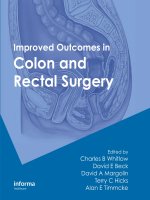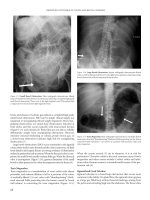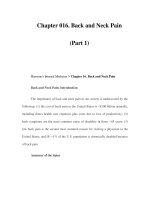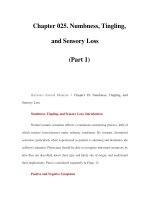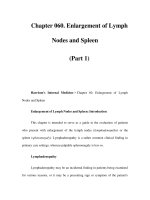ANATOMICAL TERMS AND THEIR DERIVATION - PART 1 ppsx
Bạn đang xem bản rút gọn của tài liệu. Xem và tải ngay bản đầy đủ của tài liệu tại đây (188.91 KB, 14 trang )
ANATOMICAL
TERMS
AND THEIR DERIVATION
Nov. 1, 2006 22:23 SPI-B431 Anatomical Terms and their Derivation fm FA
This page intentionally left blankThis page intentionally left blank
ANATOMICAL
TERMS
AND THEIR DERIVATION
F. PETER LISOWSKI
University of Tasmania, Australia
CHARLES E. OXNARD
University of Western Australia, Austrlia
World Scientific
NEW JERSEY . LONDON . SINGAPORE . BEIJING . SHANGHAI . HONGKONG . TAIPEI . CHENNAI
British Library Cataloguing-in-Publication Data
A catalogue record for this book is available from the British Library.
For photocopying of material in this volume, please pay a copying fee through the
Copyright Clearance Center, Inc., 222 Rosewood Drive, Danvers, MA 01923, USA. In
this case permission to photocopy is not required from the publisher.
ISBN 981-270-387-X (pbk)
Typeset by Stallion Press
Email:
All rights reserved. This book, or parts thereof, may not be reproduced in any form or by any
means, electronic or mechanical, including photocopying, recording or any information
storage and retrieval system now known or to be invented, without written permission from
the Publisher.
Copyright © 2007 by World Scientific Publishing Co. Pte. Ltd.
Published by
World Scientific Publishing Co. Pte. Ltd.
5 Toh Tuck Link, Singapore 596224
USA office: 27 Warren Street, Suite 401-402, Hackensack, NJ 07601
UK office: 57 Shelton Street, Covent Garden, London WC2H 9HE
Printed in Singapore.
ANATOMICAL TERMS AND THEIR DERIVATION
ChingTing - Anatomical terms.pmd 2/27/2007, 2:47 PM1
Nov. 1, 2006 22:23 SPI-B431 Anatomical Terms and their Derivation fm FA
ANATOMICAL TERMS AND
THEIR DERIVATION
Anatomy is gradually disappearing from the medical curriculum.
This is partly because the curriculum is overcrowded and something
has to go. It is also because medical education assumes that
anatomy’s main value is for surgery and will be learnt later by beginning
surgeons. Yet anatomy for surgery is, paradoxically, the least of the
reasons for doctors to know anatomy.There is, thus, a minor “surgery”
of general practice that requires anatomy in situations where it cannot
be“looked up.”The knife for a sebaceouscystin the neck easily leadsto
paralysis of the trapezius if anatomical knowledge has gone (or never
existed). The needle at the elbow or buttock readily causes problems
if the simple anatomy is absent (or has disappeared). Even the finger
(touching — palpation) or the eye (looking — observation) mislead if
what is under the skin has been forgotten (or was never known).
Thus, the use of anatomy is widely misunderstood; it is certainly
far wider than just surgery. Anatomy helps understand signs and
symptoms. Do we know how the local anatomy of special skin regions
relates to oedema: swelling of the back of hand and foot in the
upright patient, swelling around the eyes in the lying patient, swelling
of the genitalia (especially alarming to the patient in a cardiac bed)
in the sitting patient? Anatomy is important in clinical tests. Do we
understand: the opposite side test, pressing in left iliac fossa giving
pain in right iliac fossa in appendicitis; the obturator test, flexing and
medially rotating the right thigh causes pain from a pelvic appendix
lying on the obturator muscle? Anatomy is important in everything
we do in medicine. Do we know that accuracy in observation and
v
Nov. 1, 2006 22:23 SPI-B431 Anatomical Terms and their Derivation fm FA
Anatomical Terms and their Derivation
description stem first from observation and description in anatomy?
Do we realize that anatomical terms are the vocabulary of medicine,
not just anatomy: how doctors communicate with one another, and
with the patient?
Learning anatomy is also widely misunderstood; it is certainly far
wider than just memorization of facts. Of course, memorization is an
important aid to learning in all disciplines. Paradoxically, this is one of
the reasons for eliminating anatomy; it seems that it does not need
to be learnt; it can be “looked up.” However, the information in texts,
lists, pictures, notes, mnemonics and memory (rote-learning) though
all useful initially, disappear in short order.Anatomy is only truly known
through understanding the underlying science; development: how it
came to be during a life time; evolution:how it came to be in myriads of
life times;function:how it works;experience:how it is used;application:
when it goes wrong.
Anatomy can be learnt from text-books, atlases, models,
prosections and computers.This is second hand learning.
It can also be learnt from many bodies, of the living as well
as the dead, of teachers, fellow students, health care colleagues,
patients, and of one’s own body as well as the patient’s. This is
powerful first hand learning: listening, speaking, discussing, using,
and above all, questioning. Questioning is the final basis of learning.
All this communication requires an interface between the language of
medicine and the language of life.
All this leads to a new problem for today’s students. In prior times,
students were often relatives of doctors or other professionals already
possessing a medical flavour; they usually had English as their first
language; they had biological and classical backgrounds; they already
“knew” what the words meant. In today’s world, in contrast, many
students are from language groups (Asia, Africa, Eastern Europe, the
Middle East) far removed from English; many lack the classics and
biology that utilize the words (in Australia, biological sciences are not
vi
Nov. 1, 2006 22:23 SPI-B431 Anatomical Terms and their Derivation fm FA
Anatomical Terms and their Derivation
even required at entry); many are baffled by the language of medicine.
Such students ask:
“Why do things have such complex names?”
“If only we knew the meaning it would be easier to understand!”
The teacher of the old days who could have enlightened them is almost
extinct. The following text provides some of the information that those
teachers might have given. It has been tested on medical students
in the Universities of Tasmania and Western Australia. The student
response has been most gratifying.The small pocket word book is truly
avade mecum that goes with the student into all parts of medicine.
Anatomy began as descriptive science in the days when Latin
was the universal scientific language, and early anatomists described
the structures they saw in that language, comparing them to common
and familiar objects, or borrowing terms from the Greek and Arabic
masters before them.
In anatomic terminology, common Latin or Greek words are used
as such for any part of the body for which the ancients had a name.
For many other structures, scientific names have been invented (1)
by using certain classical words which appear to be descriptive of the
part concerned, or (2) commonly, by combining Greek or Latin roots
to form a new compound term. Memorization of such terms without
understanding their meaning can lead to mental indigestion. Here, the
roots are also presented from which many of these descriptive terms
and compounds are derived, as an aid to comprehension.For practical
convenience, the book is organised into abbreviations, prefixes and
suffixes, general terms common to all body regions, short lists for each
major body part, and an alphabetical list covering the entire body.
For a wider vocabulary, the use of a standard biological or medical
dictionary is recommended.
Our thanks go to Ms Jill Aschman, Secretary of the Anatomy and
Physiology Department who did the original word processing, and
to Dr K. K. Phua and Ms Lim Sook Cheng of World Scientific. Most
vii
Nov. 1, 2006 22:23 SPI-B431 Anatomical Terms and their Derivation fm FA
Anatomical Terms and their Derivation
important thanks of all go to generations of medical students in all
the medical schools in which we have worked. Their questions about
meanings have stimulated our answers and this pocket book.
Hobart and Perth FPL
CEO
2006
viii
Nov. 1, 2006 22:23 SPI-B431 Anatomical Terms and their Derivation fm FA
CONTENTS
Abbreviations 1
Commonly Used Prefixes 2
Commonly Used Suffixes 6
Terms Common to All Anatomical Regions 7
Terms Important in the Upper Limb 21
Terms Important in the Lower Limb 28
Terms Important in the Thorax 35
Terms Important in the Abdomen and Pelvis 44
Terms Important in the Head and Neck 58
Terms Specific to the Nervous System 74
Alphabetical List of Terms 85
ix
This page intentionally left blankThis page intentionally left blank
Nov. 1, 2006 22:21 SPI-B431 Anatomical Terms and their Derivation Abbreviations FA
ABBREVIATIONS
AS. Anglo-Saxon
A. Arabic
dim. diminutive
F. French
Ger. German
G. Greek
L. Latin
NL. “New” Latin
OF. Old French
pl. plural
1
Nov. 1, 2006 22:27 SPI-B431 Anatomical Terms and their Derivation Prefixes FA
COMMONLY USED PREFIXES
Prefix Meaning Example
a-, an- G. lacking, without asexual, without sex
ab- L. away from abduction, lead away
ad- L. to, toward adduction, lead towards
af- L. to, toward afferent, bring towards
amphi- G. on both sides,
double
amphiarthrosis, two
joints
andro- G. a male androgen, male
producing
ante- L. forward, before antebrachium, forearm
anti- G. against, reverse,
opposed to
antihelix, reverse coil
apo- G. from apocrine, secreting from
auto- G. autos, self autonomic, self
governing
basi- L. pertaining to the
base
basiocciput, occipital
base
bi- L. twice, double bicipital, two heads
brachy- G. short brachycephaly, short
head
cephalo- G. head cephalometry, head
measure
circum- L. around, about circumduction, lead
around
chondro- G. chondras,
cartilage
chondrocyte, cartilage
cell
2
Nov. 1, 2006 22:27 SPI-B431 Anatomical Terms and their Derivation Prefixes FA
Commonly Used Prefixes
co-, com-, con- L. together, with constrictor, draw together
de- L. away from, down deglutition, swallow down
di- G. double, twice diaplegia, both sides
di-, dia- G. through, between diaphragm, wall between
dis- L. apart, away disarticulate, joint apart
e-, ecto-, ex- G. on outer side ectoderm, outer layer
extra- L. extra, outside extradural, outside the
dura
em-, en- G. in, on embolism, wedge inside
en-, endo- G. within endocardium, within
heart
epi- G. upon, over epicardium, over heart
eu- G. the better of
alternates
eugenics, better
generation
exo- G. outside exophthalmos, bulging
eye
extra- L. outside extracellular, outside the
cell
gastro- G. gaster, stomach,
belly
gastrocolic reflex,
stomach-colon reflex
helico- G. twisted helicotrema, twisted hole
hemi- G. half hemisphere, half a
sphere
holo- G. whole holocrine, whole
secretion
homo- G. one and the same homologous
hyper- G. over, above,
excessive
hypertrophy, over growth
hypo- G. under, deficient,
below
hypothalamus, below the
thalamus
im-, in- L. not immature, not mature
infra- L. below infraorbital, below orbit
3

